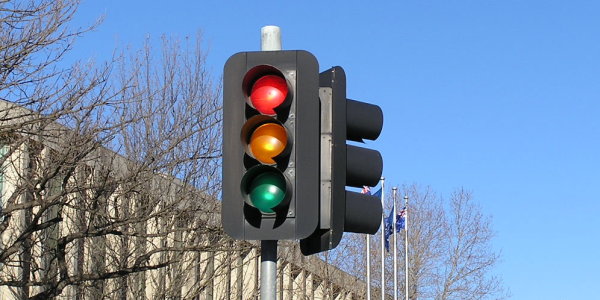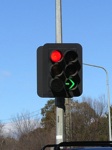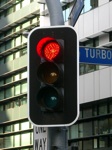|
|
|
|
|
 |
| Typical signal design used in the ACT until the early 90s, and still in use in Victoria and Northern Territory and sporadically in South Australia. This signal was located on the junction of Canberra Avenue and National Circuit, Forrest, ACT. Image © Sam Laybutt (Ozroads). |
Traffic signals first started appearing in Australia in the early 20th century. There were various types and sequences, which will be covered in this section. Also covered here is information on some of the common brands used.
The first ever traffic signals installed and operating in Australia were:
Signal Sequences:
Australian traffic lantern sequences work as follows: red, green, amber, red. However in some states, although now officially phased out, the signal sequence was red, red-amber, green, amber, red. There's still some signals in suburban Melbourne using this configuration (click here to see a video of a set in operation). See the tables below for a graphical representation.
| Current Sequence: | Older Sequence (Officially retired): | ||||||
 |
 |
 |
 |
 |
 |
 |
|
| 1 | 2 | 3 | 1 | 2 | 3 | 4 | |
Standard Australian Signals:
The tables below cover the standard Australian signals and their meaning.
| Traffic Lanterns: | |||||
 |
Red: |
 |
Red Arrow: You must not turn in the direction of the arrow. Wait behind the stop line. Do not enter the intersection. |
||
 |
Amber: Amber means stop.You can enter the intersection if you are so close to the stop line that sudden braking might cause a crash. |
 |
Amber Arrow: Amber arrow means stop.You can enter the intersection in the direction of the arrow if you are so close to the stop line that sudden braking might cause a crash. |
||
 |
Green: |
 |
Green Arrow: Green means proceed through the intersection in the direction of the arrow carefully. |
||
| Bus & Tram Signals: | |||||
 |
Bus Signal - Red: |
 |
Tram Signal - Red: |
||
 |
Bus Signal - Amber: Amber means any buses must stop. They can enter the intersection if they are so close to the stop line that sudden braking might cause a crash. |
 |
Tram Signal - Amber: Amber means any trams must stop. They can continue if they are so close to the stopping point that sudden stopping might cause a crash or injury to passengers. |
||
 |
Bus Signal - White: |
 |
Tram Signal - White: |
||
| Other Signals: | |||||
| Pedestrian Signal - Old Style Don't Walk: Older pedestrian signal, which was phased out in the early 1980s, however some still remain in service. |
Pedestrian Signal - Don't Walk: Current style pedestrian signal, using a red man to indicate 'Don't Walk'. |
||||
| Pedestrian Signal - Old Style Walk: Older pedestrian signal, which was phased out in the early 1980s, however some still remain in service. |
Pedestrian Signal - Walk: Current style pedestrian signal, using a green man to indicate 'Walk'. |
||||
| Pedestrian Signal - Old Style Neon Don't Walk: Older pedestrian signal, which was phased out in the 1960s, however some still remain in service in Melbourne. |
Bicycle Signal - Stop: Signal especially for bicycle riders, using a red bicycle to indicate 'Stop'. |
||||
| Pedestrian Signal - Old Style Neon Walk: Older pedestrian signal, which was phased out in the 1960s, however some still remain in service in Melbourne. |
Bicycle Signal - Go: Signal especially for bicycle riders, using a green bicycle to indicate 'Go'. |
||||
| Lane Allocation Signal - Lane Closed: Placed over a traffic lane to indicate its status, can be used in tidal flow systems and inside tunnels. |
|||||
| Lane Allocation Signal - Lane Closing: Placed over a traffic lane to indicate its status, can be used in tidal flow systems and inside tunnels. This signal usually flashes when displayed. |
|||||
| Lane Allocation Signal - Lane Open: Placed over a traffic lane to indicate its status, can be used in tidal flow systems and inside tunnels. |
|||||
Manufacturers:
Several signal manufacturers products have been used over the years, and in many cases components from several companies can make up a set of signals. The table below, albeit most probably not entirely complete, covers some of these manufacturers and the products they made.
| Company: | In Business? | Signal Heads | Controllers | Call Buttons |
| ATS / Aldridge Traffic Systems | Yes | X | X | X |
| AWA (Amalgamated Wireless Australasia) / AWA Plessey | Yes, but no longer in the signal business | X | X | X |
| Bob Panich | Yes | X | X | |
| Braums | Yes | X | X | |
| Eagle Signal Company of Australia | No, bought out in 1984 by Aldridge Traffic Systems | X | X | X |
| Excelsior | Unknown, possibly bought out by Aldridge Traffic Systems | X | X | |
| Excel Technology Group | Yes | X | ||
| Gulf & Western | See Eagle Signal Company | X | X | |
| Marshalite | No | X | X | |
| Philips | Yes, but information on their controllers is scarce | X | ||
| QTC Traffic Solutions | Yes | X | ||
| Siemens | Yes | X | X | X |
Signal Photos:
This site has a large collection of signal photos from right across Australia. Each state varies the way they set their signals up. The photos include both past and present signals. Click on a category below:
 |
 |
 |
 |
| Vintage (Pre 1980s) | 1980s | 1990s | Current |
Signal Videos:
Here's a small collection of videos showing the various signal sequences, click on the play button control to view:
| Current Traffic Sequence: The signalling sequence used right across Australia for traffic lanterns. Video © Darren Hodges |
Pedestrian Signal Sequence: Full cycle of standard Australian pedestrian signal. Video © Darren Hodges |
|
| Older Red-Amber Phasing: The now defunct red-amber phase before green sequence. Video © Darren Hodges |
Pedestrian Signal Sequence: Video © Sam Laybutt (Ozroads). |
Australian Traffic Signal Location Database:
Below is the Australian traffic signal location database, based on data collected and supplied by Lachlan Sims. Last updated: August 2020. All states and territories except Victoria are currently covered.
Enter a site number, road name, suburb name or local government area to search or include or exclude data.
Last updated: 04-Aug-2020 0:10
This site © Paul Rands. All rights reserved. Some portions © (copyright) by their respective and credited owners. Permission must be obtained before using any images from this site. For details, please email by clicking here.